Business
Netherland’s renewables drive putting pressure on its power grid
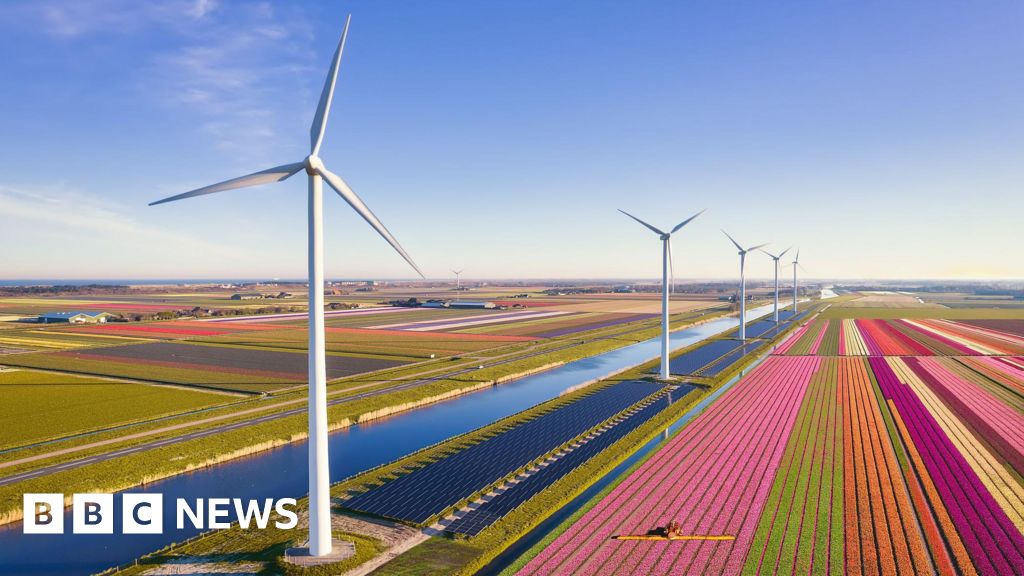
John LaurensonBusiness reporter, Rotterdam
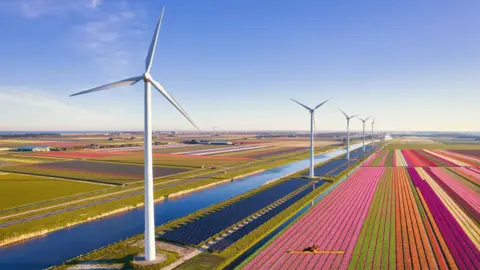 AFP via Getty Images
AFP via Getty ImagesIn a Dutch government TV campaign called “Flip the Switch” an actress warns viewers about their electricity usage.
“When we all use electricity at the same time, our power grid gets overloaded,” she says. “This can cause malfunctions. So, use as little electricity as possible between four and nine.”
It is the sign that, in one of the most-advanced economies in the world, something has gone wrong with the country’s power supply.
The Netherlands has been an enthusiastic adopter of electric cars. It has the highest number of charging points per capita in Europe.
As for electricity production, the Netherlands has replaced gas from its large North Sea reserves with wind and solar.
So much so that it leads the way in Europe for the number of solar panels per person. In fact, more than one third of Dutch homes have solar panels fitted.
The country is also aiming for offshore wind farms to be its biggest source of energy by 2030.
This is all good in environmental terms, but it’s putting the Dutch national electricity grid under enormous stress, and in recent years there have been a number of power cuts.
The problem is “grid congestion”, says Kees-Jan Rameau, chief executive of Dutch energy producer and supplier Eneco, 70% of whose electricity generation is now solar and wind.
“Grid congestion is like a traffic jam on the power grid. It’s caused by either too much power demand in a certain area, or too much power supply put onto the grid, more than the grid can handle.”
He explains that the problem is that the grid “was designed in the days when we had just a few very large, mainly gas-fired power plants”.
“So we built a grid with very big power lines close to those power plants, and increasingly smaller power lines as you got more towards the households.
“Nowadays we’re switching to renewables, and that means there’s a lot of power being injected into the grid in the outskirts of the network where there are only relatively small power lines.”
And these small power lines are struggling to cope with all the electricity coming in from wind turbines and solar panels scattered around the country.
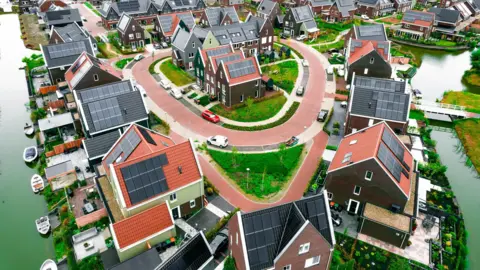 AFP via Getty Images
AFP via Getty ImagesDamien Ernst, professor of electrical engineering at Belgium’s Liege University, is one of Europe’s leading experts on electricity grids. He says it is an expensive problem for the Netherlands to solve.
“They have a grid crisis because they haven’t invested enough in their distribution networks, in their transmission networks, so they are facing bottlenecks everywhere, and it will take years and billions of dollars to solve this.”
Prof Ernst adds that it is a Europe-wide issue. “We have an enormous amount of solar panels being installed, and they are installed at a rate that is much, much too high for the grid to be able to accommodate.”
At Eneco’s headquarters in Rotterdam, Mr Kees-Jan Rameau highlights a large control panel that the company calls its “virtual power plant” and “the brain of our operations”. It is used to help balance the grid, avoiding blackouts.
When electricity generation is too high across the Netherlands, it enables Eneco to turn wind turbines out of the wind and turn off solar panels.
As for when demand for electricity is too high, it lowers the power to customers who have accepted to allow Eneco to stop or reduce their electricity supply when the network is under strain in exchange for lower prices.
But for homes and companies who want to scale-up their use of electricity with a new or larger grid connection, that, increasingly, is just not possible.
“Often consumers want to install a heat pump, or charge their electric vehicle at home, but that requires a much bigger power connection, and increasingly they just cannot get it,” says Mr Kees-Jan Rameau.
He adds that it is worse for businesses. “Often they want to expand their operations, and they just cannot get extra capacity from the grid operators.
And it has got to the point where even new housing construction in the Netherlands is becoming increasingly difficult, because there’s just no capacity to connect those new neighbourhoods to the grid.”
Those people, and companies, end up on waiting lists for a number of years. At the same time there are also waiting lists for those who want to supply the grid with power, such as a new home fitted with solar panels on its roof.
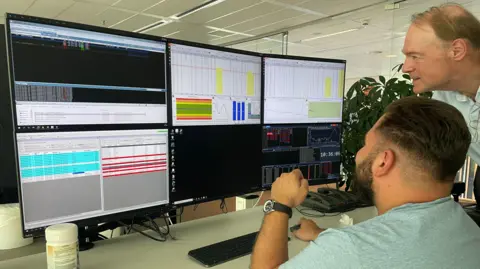
Tennet, the government-owned agency that runs the Netherlands’ national grid, says that 8,000 companies are currently waiting to be able to feed in electricity, while 12,000 others are waiting for permission to use more power.
Some sectors of the Dutch economy are warning that it is hampering their growth. “Grid congestion is putting the future of the Dutch chemical industry at risk… while in other countries it will be easier to invest,” says the President of the Dutch Chemical Association Nienke Homan.
So, was all this avoidable? “In hindsight I think almost every problem is avoidable,” says Mr Kees-Jan Rameau.
He adds that following the 2015 Paris Agreement on trying to tackle climate change, “we were very much focussing on increasing the renewable power generation side. But we kind of underestimated the impact it would have on the power grid.”
Tennet is now planning to spend €200bn ($235bn; £174bn) on reinforcing the grid, including laying some 100,000km (62,000 miles) of new cables between now and 2050.
That’s a huge amount of money, but there is also a big cost to not spending it. Grid congestion is costing the Dutch economy up to €35bn a year, according to a 2024 report from management consultancy group Boston Consulting Group.
Eugene Beijings, who is in charge of grid congestion with Tennet, says that patience is sadly required. “To strengthen and reinforce the grid, we need to double, triple, sometimes increase tenfold the capacity of the existing grid.
“And it’s taking on average about 10 years to do a project like that before it goes live, of which the first eight are legislation and getting the rights to put cables in the ground with all property owners. And only the last two years are the construction period.
“And meanwhile the energy transition is going that fast that we cannot cope with it, with the existing grid. So every additional request [to connect] is adding to the waiting list.”
 Zet ook de knop om
Zet ook de knop omAt the Dutch energy ministry, which is actually called the Ministry for Climate Policy and Green Growth, the Minister Sophie Hermans wasn’t available for an interview. But her office gave a statement:
“In hindsight, the speed at which our electricity consumption has grown might have been collectively underestimated in the past by all parties involved. It is also hard to predict where the growth will occur first, as this results from individual companies/sectors and households.”
As for solutions, the ministry says it has a “National Grid Congestion Action Plan” focussed on adjusting legislation so grid expansion permits can be granted more quickly.
It is encouraging people to make better use of the existing grid with, for example, its Flip the Switch campaign.
And the financial incentive for people who feed their surplus solar electricity into the grid is being reduced to almost nothing. In some cases, people will even have to pay to feed solar power into the grid.
Business
Eli Lilly cuts cash prices of Zepbound weight loss drug vials on direct-to-consumer site

The Eli Lilly logo appears on the company’s office in San Diego, California, U.S., Nov. 21, 2025.
Mike Blake | Reuters
Eli Lilly on Monday said it is lowering the cash prices of single-dose vials of its blockbuster weight loss drug Zepbound on its direct-to-consumer platform, LillyDirect, building on efforts by the company and the Trump administration to make the medicine more accessible.
The announcement also comes weeks after chief rival Novo Nordisk unveiled additional discounts on the cash prices of its obesity and diabetes drugs.
Starting Monday, cash-paying patients with a valid prescription can get the starting dose of Zepbound vials for as low as $299 per month on LillyDirect, down from a previous price of $349 per month. They can also access the next dose, 5 milligrams, for $399 per month and all other doses for $449 per month, down from $499 per month across those sizes.
Zepbound carries a list price of roughly $1,086 per month. That price point, and spotty insurance coverage for weight loss drugs in the U.S., have been significant barriers to access for some patients.
Eli Lilly’s announcement comes just weeks after President Donald Trump inked deals with Eli Lilly and Novo Nordisk to make their GLP-1 drugs easier for Americans to get and afford. The agreements will cut the prices the government pays for the drugs, introduce Medicare coverage of obesity drugs for the first time for certain patients and offer discounted medicines on the government’s new direct-to-consumer website launching in January, TrumpRx.
But Eli Lilly’s deal with Trump centers around lowering the prices of a different form of Zepbound – a multi-dose pen – after it wins Food and Drug Administration approval.
That means Eli Lilly’s Monday announcement around cutting prices on the existing single-dose vials could allow more patients to get discounted treatments more quickly.
“We will keep working to provide more options — expanding choices for delivery devices and creating new pathways for access — so more people can get the medicines they need,” said Ilya Yuffa, president of Lilly USA and global customer capabilities, in a statement.
Eli Lilly’s stock, which has climbed more than 36% this year, fell nearly 2% on Monday. Its meteoric rise due to the success of Zepbound and its diabetes injection Mounjaro vaulted it to becoming the first health-care company to hit a $1 trillion market value last month. Though cutting prices means lower revenue per medication sold, Eli Lilly’s sales — and shares — have continued to soar through past pricing announcements as demand balloons.
With single-dose vials, patients need to use a syringe and needle to draw up the medicine and inject it into themselves. Eli Lilly first introduced that form of Zepbound in August 2024.
It’s unclear how many patients are currently using single-dose vials of Zepbound. But Eli Lilly previously said that direct-to-consumer sales now account for more than a third of new prescriptions of Zepbound.
Novo Nordisk earlier this month lowered the price of its obesity drug Wegovy and diabetes treatment Ozempic for existing cash-paying patients to $349 per month from $499 per month. That excludes the highest dose of Ozempic.
The company also launched a temporary introductory offer, which will allow new cash-paying patients to access the two lowest doses of Wegovy and Ozempic for $199 per month for the first two months of treatment.
Business
OGRA Announces LPG Price Increase for December – SUCH TV

The Oil and Gas Regulatory Authority (OGRA) has approved a fresh increase in the price of liquefied petroleum gas (LPG), raising the cost for both domestic consumers and commercial users.
According to the notification issued, the LPG price has been increased by Rs7.39 per kilogram, setting the new rate at Rs209 per kg for December. As a result, the price of a domestic LPG cylinder has risen by Rs87.21, bringing the new price to Rs2,466.10.
In November, the price of LPG stood at Rs201 per kg, while the domestic cylinder was priced at Rs2,378.89.
The latest price hike is expected to put additional pressure on households already grappling with rising living costs nationwide.
Business
Taxable Value Of Goods Surges 15% In Sep-Oct As GST Cuts Boost Consumption
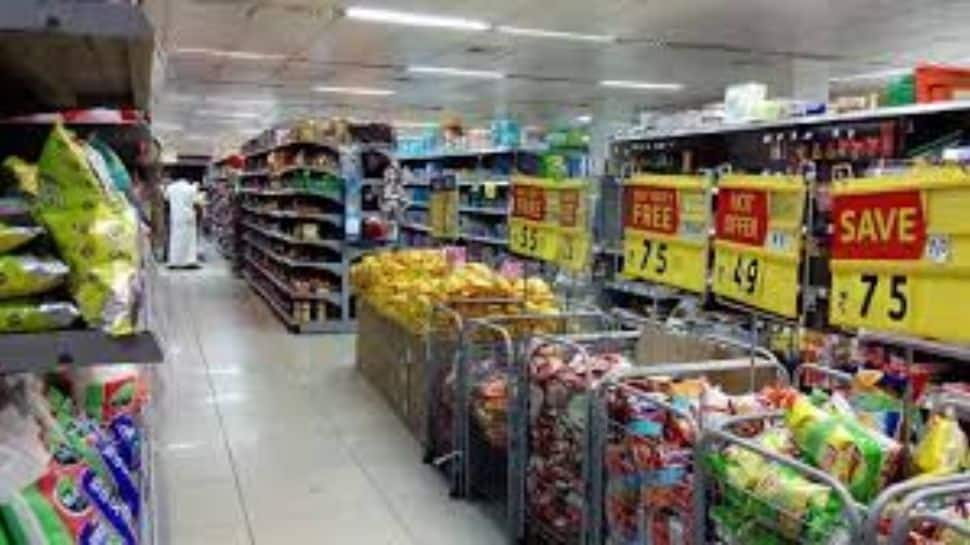
New Delhi: The taxable value of all supplies under GST surged by a robust 15 per cent during September-October this year, compared to the same period in 2024 due to sharp increase in consumption triggered by the tax rate cuts on goods across sectors that kicked in from September 22, according to official sources.
The growth in the same two-month period last year was 8.6 per cent. “This surge in taxable value during ‘Bachat Utsav’ demonstrates strong consumption uplift, stimulated by reduced rates and improved compliance behaviour,” a senior official said.
He pointed out that the growth has especially been strong in sectors where rate rationalisation was implemented, such as FMCG, pharma goods, food products, automobiles, medical devices and textiles. In these sectors, the taxable value of supplies has seen significantly higher growth, confirming that lower GST rates translated directly into higher consumer spending.
“It vindicates our strategy that reducing rates on essentials and mass-use sectors would create demand-side buoyancy — a Laffer Curve–type demand uplift,” he explained.These trends confirm that GST next-gen reforms have not disrupted revenue stability, and that consumption-side buoyancy has begun to translate into higher taxable value in key sectors.
This growth is in value terms which means that since GST rates were lower, the growth in volume terms will be even higher. It is clearly visible that while the Next Gen Reforms resulted in significant Bachat — increased consumption, industry has been very proactive in passing on the GST savings to the final consumers and ensuring that there is no supply side deficiency.
As GDP private consumption data will be released much later, GST taxable value serves as the most reliable real-time proxy for consumption, and the current numbers clearly indicate sustained demand expansion, the official added.
-

 Sports1 week ago
Sports1 week agoWATCH: Ronaldo scores spectacular bicycle kick
-

 Entertainment1 week ago
Entertainment1 week agoWelcome to Derry’ episode 5 delivers shocking twist
-

 Politics1 week ago
Politics1 week agoWashington and Kyiv Stress Any Peace Deal Must Fully Respect Ukraine’s Sovereignty
-

 Business1 week ago
Business1 week agoKey economic data and trends that will shape Rachel Reeves’ Budget
-

 Politics1 week ago
Politics1 week ago53,000 Sikhs vote in Ottawa Khalistan Referendum amid Carney-Modi trade talks scrutiny
-

 Tech6 days ago
Tech6 days agoWake Up—the Best Black Friday Mattress Sales Are Here
-

 Tech1 day ago
Tech1 day agoGet Your Steps In From Your Home Office With This Walking Pad—On Sale This Week
-

 Fashion1 week ago
Fashion1 week agoCanada’s Lululemon unveils team Canada kit for Milano Cortina 2026






